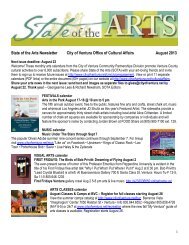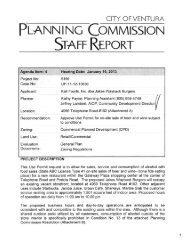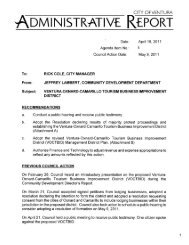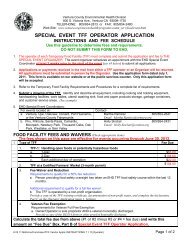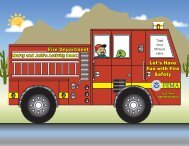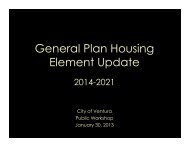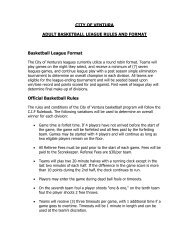Saticoy & Wells Community Plan & Development ... - City Of Ventura
Saticoy & Wells Community Plan & Development ... - City Of Ventura
Saticoy & Wells Community Plan & Development ... - City Of Ventura
Create successful ePaper yourself
Turn your PDF publications into a flip-book with our unique Google optimized e-Paper software.
<strong>Saticoy</strong> & <strong>Wells</strong> <strong>Community</strong> <strong>Plan</strong> and Code EIRSection 4.3 Air Qualitysensitive receptors. It is not possible to predict where all future development might occur, butvirtually any new development within the Project Area is likely to be adjacent to or near one ormore sensitive receptors.As mentioned above, the VCAPCD has not adopted significance thresholds for constructionrelatedemissions since such emissions are temporary. Nevertheless, the <strong>Ventura</strong> County AirQuality Assessment Guidelines (October 2003) recommend various techniques to reduceconstruction-related emissions associated with individual developments. These includetechniques to limit emissions of both ozone precursors (NO X and ROC) and fugitive dust (PM 10 )and are identified below:• Minimize equipment idling time.• Maintain equipment engines in good condition and in proper tune as permanufacturers’ specifications.• Lengthen the construction period during smog season (May through October), tominimize the number of vehicles and equipment operating at the same time.• Use alternatively fueled construction equipment, such as compressed natural gas(CNG), liquefied natural gas (LNG), or electric, if feasible.• The area disturbed by clearing, grading, earth moving, or excavation operations shallbe minimized to prevent excessive amounts of dust.• Pre-grading/excavation activities shall include watering the area to be graded orexcavated before commencement of grading or excavation operations. Application ofwater (preferably reclaimed, if available) should penetrate sufficiently to minimizefugitive dust during grading activities.• Fugitive dust produced during grading, excavation, and construction activities shallbe controlled by the following activities:a) All trucks shall be required to cover their loads as required by California VehicleCode §23114.b) All graded and excavated material, exposed soil areas, and active portions of theconstruction site, including unpaved on-site roadways, shall be treated toprevent fugitive dust. Treatment shall include, but not necessarily be limited to,periodic watering, application of environmentally-safe soil stabilizationmaterials, and/or roll-compaction as appropriate. Watering shall be done as oftenas necessary and reclaimed water shall be used whenever possible.• Graded and/or excavated inactive areas of the construction site shall be monitored bythe <strong>City</strong> Building Inspector at least weekly for dust stabilization. Soil stabilizationmethods, such as water and roll-compaction, and environmentally-safe dust controlmaterials, shall be periodically applied to portions of the construction site that areinactive for over four days. If no further grading or excavation operations areplanned for the area, the area should be seeded and watered until grass growth isevident, or periodically treated with environmentally-safe dust suppressants, toprevent excessive fugitive dust.• Signs shall be posted on-site limiting traffic to 15 miles per hour or less.• During periods of high winds (i.e., wind speed sufficient to cause fugitive dust toimpact adjacent properties), all clearing, grading, earth moving, and excavationoperations shall be curtailed to the degree necessary to prevent fugitive dust createdby on-site activities and operations from being a nuisance or hazard, either off-site or4.3-12<strong>City</strong> of <strong>Ventura</strong>




